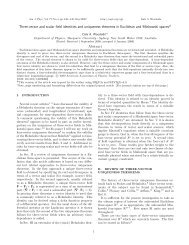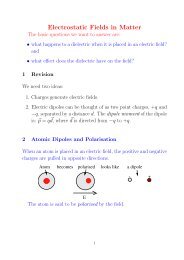Chapter 8 Vector Spaces in Quantum Mechanics
Chapter 8 Vector Spaces in Quantum Mechanics
Chapter 8 Vector Spaces in Quantum Mechanics
Create successful ePaper yourself
Turn your PDF publications into a flip-book with our unique Google optimized e-Paper software.
<strong>Chapter</strong> 8 <strong>Vector</strong> <strong>Spaces</strong> <strong>in</strong> <strong>Quantum</strong> <strong>Mechanics</strong> 95Free Particle We can generalize the preced<strong>in</strong>g model by suppos<strong>in</strong>g that the spac<strong>in</strong>gbetween the neighbour<strong>in</strong>g atoms is allowed to go to zero, so that the positions at whichthe electron can be found become cont<strong>in</strong>uous. This then acts as a model for the descriptionof a particle free to move anywhere <strong>in</strong> one dimension. In sett<strong>in</strong>g up this model, we f<strong>in</strong>dthat as well as there be<strong>in</strong>g an <strong>in</strong>f<strong>in</strong>ite number of basis states – someth<strong>in</strong>g we have alreadyencountered – we see that these basis states are not discrete, i.e. a particle at position xwill be <strong>in</strong> the basis state |x〉, and as x can vary cont<strong>in</strong>uously over the range −∞ < x < ∞,there will be a non-denumerably <strong>in</strong>f<strong>in</strong>ite, that is, a cont<strong>in</strong>uous range of such basis states.As a consequence, the completeness relation ought to be written as an <strong>in</strong>tegral:|ψ〉 =∫ +∞−∞|x〉〈x|ψ〉 dx. (8.63)The states |x〉 and |x ′ 〉 will be orthonormal if x x ′ , but <strong>in</strong> order to be able to reta<strong>in</strong> thecompleteness relation <strong>in</strong> the form of an <strong>in</strong>tegral, it turns out that these basis states have tohave an <strong>in</strong>f<strong>in</strong>ite norm. However, there is a sense <strong>in</strong> which we can cont<strong>in</strong>ue to work withsuch states, as will be discussed <strong>in</strong> Section 8.6.Particle <strong>in</strong> an Inf<strong>in</strong>itely Deep Potential Well We saw <strong>in</strong> Section 5.3 that a particleof mass m <strong>in</strong> an <strong>in</strong>f<strong>in</strong>itely deep potential well of width L can have the energies E n =n 2 π 2 2 /2mL 2 where n is a positive <strong>in</strong>teger. This suggests that the basis states of theparticle <strong>in</strong> the well be the states |n〉 such that if the particle is <strong>in</strong> state |n〉, then it hasenergy E n . The probability amplitude of f<strong>in</strong>d<strong>in</strong>g the particle at position x when <strong>in</strong> state |n〉is then 〈x|n〉 which, from Section 5.3 we can identify with the wave function ψ n , i.e.ψ n (x) = 〈x|n〉 =√2L s<strong>in</strong>(nπx/L) 0 < x < LThe state space is obviously of <strong>in</strong>f<strong>in</strong>ite dimension.= 0 x < 0, x > L. (8.64)It has been po<strong>in</strong>ted out before that a state space can have any number of sets of basisstates, i.e. the states |n〉 <strong>in</strong>troduced here do not form the sole possible set of basis statesfor the state space of this system. In this particular case, it is worthwhile not<strong>in</strong>g that wecould have used as the base states the states labelled by the position of the particle <strong>in</strong> thewell, i.e. the states |x〉.As we have seen, there are an <strong>in</strong>f<strong>in</strong>ite number of such states which <strong>in</strong> a way is to beexpected as we have already seen that the state space is of <strong>in</strong>f<strong>in</strong>ite dimension. But thedifference between this set of states and the set of states |n〉 is that <strong>in</strong> the latter case, thesestates are discrete, i.e. they can be labelled by the <strong>in</strong>tegers, while the states |x〉 are cont<strong>in</strong>uous,they are labelled by the cont<strong>in</strong>uous variable x. Thus, someth<strong>in</strong>g new emergesfrom this example: for state spaces of <strong>in</strong>f<strong>in</strong>ite dimension, it is possible to have a denumerably<strong>in</strong>f<strong>in</strong>ite number of basis states (i.e. the discrete states |n〉) or non-denumerably<strong>in</strong>f<strong>in</strong>ite number of basis states (i.e. the states |x〉.) This feature of state spaces of <strong>in</strong>f<strong>in</strong>itedimension, plus others, are discussed separately below <strong>in</strong> Section 8.6.A System of Identical Photons Many other features of a quantum system not related tothe position or energy of the system can be used as a means by which a set of basis states
















